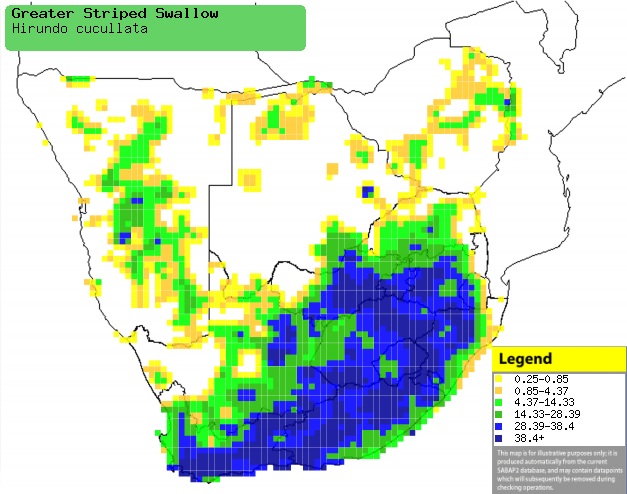Hirundo cucullata (Greater
striped swallow)
Grootstreepswael [Afrikaans]; Inkonjane (generic term for
swallows) [Xhosa]; iNkonjane (generic term for swallows) [Zulu]; Sisampamema
(generic term for swallows, martins, swifts and spinetails) [Kwangali];
Lefokotsane (generic term for swallow), 'Malinakana (also applied to Barn
swallow) [South Sotho]; Nyenganyenga (generic name for swallow or martin)
[Shona]; Mbawulwana, Nyenga (generic term for swallow) [Tsonga]; Pêolwane,
Phêtla (generic terms for swifts, martins and swallows) [Tswana]; Kaapse zwaluw
[Dutch]; Hirondelle à tête rousse [French]; Große streifenschwalbe [German];
Andorinha-estriada-grande [Portuguese]
Life
> Eukaryotes >
Opisthokonta
> Metazoa (animals) >
Bilateria >
Deuterostomia > Chordata >
Craniata > Vertebrata (vertebrates) > Gnathostomata (jawed
vertebrates) > Teleostomi (teleost fish) > Osteichthyes (bony fish) > Class:
Sarcopterygii (lobe-finned
fish) > Stegocephalia (terrestrial
vertebrates) > Tetrapoda
(four-legged vertebrates) > Reptiliomorpha > Amniota >
Reptilia (reptiles) >
Romeriida > Diapsida > Archosauromorpha > Archosauria >
Dinosauria
(dinosaurs) > Saurischia > Theropoda (bipedal predatory dinosaurs) >
Coelurosauria > Maniraptora > Aves
(birds) > Order: Passeriformes
> Family: Hirundinidae
Distribution and habitat
Endemic to Africa south of the equator, occurring from
southern DRC, Angola and Zambia to southern Africa. Here it occurs across much
of South Africa excluding the arid north-western Karoo and the extremities of
Limpopo Province. It also occupies central Namibia, central and eastern Zimbabwe
and small areas of Botswana. It generally prefers open habitats such as
grassland, fynbos, karoo, open savanna, suburban areas, cultivated land and
farmyards.
|
 |
|
Distribution of Greater striped swallow in
southern Africa, based on statistical smoothing of the records from
first SA Bird Atlas Project (©
Animal Demography unit, University of
Cape Town; smoothing by Birgit Erni and Francesca Little). Colours range
from dark blue (most common) through to yellow (least common).
See here for the latest distribution
from the SABAP2. |
Brood parasites
It has been recorded as host of the
Greater honeyguide.
Movements and migrations
Intra-African breeding migrant, arriving from its central
African non-breeding grounds around July-August in the Limpopo Province, Western
and Eastern Cape. It reaches Swaziland, Botswana and KwaZulu-Natal during
September-October, eventually leaving the region around April-May.
Food
It mainly eats insects, doing most of its foraging aerially
along with other swallows or swifts, hawking prey over open grassland, large
stretches of water and around man-made structures. The following food
items have been recorded in its diet:
- Insects
- Fruit of Morus (mulberries)
- Arils of Acacia cyclops (Rooikrans)
Breeding
- Monogamous, solitary nester, one breeding pair usually produces 2-3 broods
per breeding season. Pair bonds last for the duration of the breeding
process, after which the pair go their separate ways. If one adult dies his
mate immediately tries find a new partner. If this fails one of the
offspring from a previous breeding season returns to mate with the widowed
parent.
- Both sexes construct the nest which is a bowl of mud pellets, thickly
lined with feathers and grass. An approximately 7-23 cm long tubular
entrance is placed on the side of the structure. It can be placed in a
variety of places, such as under a rock overhang, free-standing boulder or
fallen tree. Artificial sites are commonly used, especially under a road
culvert, eaves or veranda of a building, old mine workings or in a nest box.
- Egg-laying season is from August-April, peaking from November-March.
- It lays 2-4 eggs, which are incubated solely by the female for 16-20
days.
- The chicks are fed by both adults, leaving the nest after approximately
23-30 days. The young still roost in the nest up to 3 weeks after fledging.
Threats
Not threatened, in fact its numbers have increased due to
the abundance of man-made nest sites.
References
-
Hockey PAR, Dean WRJ and Ryan PG 2005. Roberts
- Birds of southern Africa, VIIth ed. The Trustees of the John Voelcker
Bird Book Fund, Cape Town.
|
